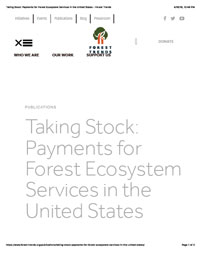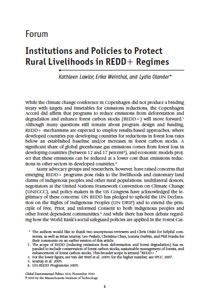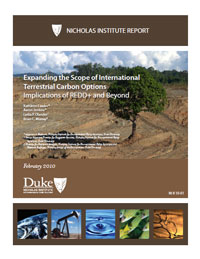Publications
Stacking Ecosystem Services Payments: Risks and Solutions
A wide variety of incentive programs and markets have arisen to pay landowners for ecosystem services--the benefits that healthy ecosystems provide, such as water filtration, biodiversity, habitat protection, and carbon sequestration. This raises questions about whether landowners can receive more than one payment for ecosystem services generated from the same parcel of land, a practice known as "stacking." This paper outlines the different types of ecosystem service credits that can be stacked, and introduces a conceptual framework that can help policy makers and project developers determine whether a stacked project is meeting the objective of replacing or enhancing ecosystem services. It also identifies three specific circumstances in which stacking can lead to a negative outcome for ecosystem services and puts forward specific policy proposals to address these issues.
C-AGG, T-AGG, and M-AGG: A model for building collaborative actions and common understanding on agricultural GHG mitigation
A new Climate Change Agriculture and Food Security working paper, led by the Nicholas Institute for Environmental Policy Solutions’ Lydia Olander, provides an overview of three interrelated initiatives for greenhouse gas mitigation: the Coalition on Agricultural Greenhouse Gases (C-AGG), the Technical Working Group on Agricultural Greenhouse Gases (T-AGG) and the Market Mechanisms for Agricultural Greenhouse Gases (M-AGG). Working together, all three have aided in engaging U.S. scientists, farmers and policy makers in sharing information and better communicating to advance agricultural greenhouse gas mitigation opportunities and efforts. Similar networking approaches may be effective for accelerating progress in developing countries.
State of the Science on Coastal Blue Carbon: A Summary for Policy Makers
The natural science of blue carbon is evolving rapidly, and many policy makers remain uncertain about the biophysical potential of these habitats as engines of carbon storage. To better manage the ecosystem services provided by coastal blue carbon, we need a good scientific understanding of how coastal habitats sequester and store carbon, where on the planet carbon is stored in these habitats, how rapidly the habitats are being modified with a risk of carbon release into the atmosphere or water column, and the mechanisms and rate of carbon emissions that follow habitat conversion. This report examines the current science as it relates to these topics. In doing so, it aims to give policy makers a feel for what is known and unknown about coastal blue carbon.
Green Payments for Blue Carbon: Economic Incentives for Protecting Threatened Coastal Habitats
This report examines the critical question of whether monetary payments for blue carbon—carbon captured and stored by coastal marine and wetland ecosystems—can alter economic incentives to favor protection of coastal habitats such as mangroves, seagrass meadows, and salt marshes. This idea is analogous to payments for REDD+ (reduced emissions from deforestation and degradation), an instrument of global climate policy that aims to curtail forest clearing, especially in the tropics. Like payments for REDD+, incentives to retain rather than emit blue carbon would preserve biodiversity as well as a variety of other ecosystem services at local and regional scales.
Taking Stock: Payments for Forest Ecosystem Services in the United States
This report compiles data on a wide range of payments for forest-based ecosystem services, including government conservation incentive programs, voluntary markets and compliance-driven ecosystem service markets such as wetland mitigation credits. According to the report, U.S. forest land owners received more than $1.9 billion dollars in payments for ecosystem services (PES). Furthermore, the report states that because of the lack of data for some markets and payments, this figure is likely a low-end estimate. In addition, more than 80 precent of all forest-based PES money in the U.S. came from non-governmental sources, including payments for wetland mitigation, hunting leases, conservation easements and carbon offsets. The remaining 20 percent came from government incentive programs such as the Conservation Reserve Program or the Environmental Quality Incentives Program.
Demand for REDD Carbon Credits: A Primer on Buyers, Markets, and Factors Impacting Prices
This paper provides an overview of the demand for forest carbon, including potential buyers and their objectives, markets for forest carbon, and forces that affect the price of forest carbon. It is intended for parties and organizations who are considering developing forest carbon projects, as an aid to understanding the changing market and demand for forest carbon credits. While the primary focus of the paper is on markets and demand for REDD credits—credits arising from projects that reduce emissions from deforestation and degradation—much of the information is applicable to afforestation and reforestation projects, as well as improved forest management.
Payments for Blue Carbon: Potential for Protecting Threatened Coastal Habitats
Coastal habitats worldwide are under increasing threat of destruction through human activities such as farming, aquaculture, timber extraction, or real estate development. This loss of habitat carries with it the loss of critical functions that coastal ecosystems provide: support of marine species, retention of shorelines, water quality, and scenic beauty, to name a few. These losses are large from an ecological standpoint but they are economically significant as well. Because the value of these ecosystem services is not easily captured in markets, those who control these lands often do not consider these values when choosing whether to clear the habitat to produce goods that can be sold in the marketplace. This is a form of market failure that leads to excessive habitat destruction. As a result, scientists, policymakers, and other concerned parties are seeking ways to change economic incentives to correct the problem. This is a revised version of a previously published policy brief.
Institutions and Policies to Protect Rural Livelihoods in REDD+ Regimes
While there is a growing interest among researchers and practitioners concerning the risks that emerging REDD+ regimes pose to rural livelihoods, there has been little scholarly analysis of specific policies that could be applied to guard against these risks. This paper argues that for REDD+ regimes to avoid negative impacts on local populations, social safeguard policies will need to overcome the significant barriers posed by ambiguous property rights and week governance and create five institutional conditions.
Policy Impacts on Deforestation: Lessons Learned from Past Experiences to Inform New Initiatives
A new Nicholas Institute report looks at the successes and failures of previous policy attempts to stem deforestation and suggests a way forward for global policy efforts to reduce emissions of greenhouse gas from deforestation.
Expanding the Scope of International Terrestrial Carbon Options: Implications of REDD+ and Beyond
Programs for reducing emissions from deforestation and degradation (REDD) in developing countries through climate policy enjoy wide support. Indeed, this support is affirmed by the Copenhagen Accord, which notes the importance of reducing emissions and enhancing carbon removals in forests. And while important implementation details have yet to be decided, the Copenhagen Accord also pledges to immediately establish a mechanism and mobilize financial support from developed and developing countries to undertake such actions in their forests. By nothing that this finance will support a REDD+ system, the Accord also seems to support the notion of expanding the scope of land-use accounting and policy incentives beyond just reducing deforestation and degradation.










